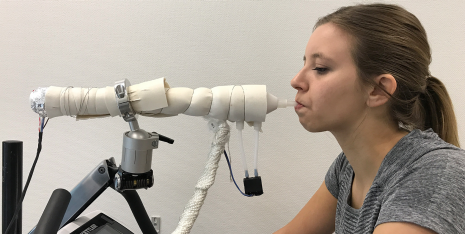Blow into the tube, please. In the future, the procedure will not just be used by police checking for alcohol intoxication, but also for testing the condition of athletes and for people who want to lose that extra bit of weight. A sensor developed by ETH researchers makes it possible to measure when the body starts burning fat with a convenient breathalyser.
Experts advise anyone looking to shed extra kilos to eat less and exercise more. One way is with endurance training, during which the body burns not only carbohydrates such as sugar, but also fat. When exactly the body begins burning fat can now be determined by analysing, for example, biomarkers in the blood or urine. Scientists at ETH Zurich and the University Hospital Zurich have now developed a method for the highly convenient, real-time monitoring of lipolysis by testing a person’s exhalations during exercise.
Major individual differences
Scientific opinion used to hold that athletes only begin burning fat after a certain period of physical exertion and on reaching a certain heart rate, but this view is now outdated. The measurements taken by the researchers in Zurich showed that lipolysis in some test subjects did, in fact, only start towards the end of the one-and-a-half-hour training session. In the other volunteers, the measurements showed that their bodies began burning fat much sooner.
Control measurements showed that the new measurement method correlated well with the concentration of the biomarker beta-hydroxybutyrate in the blood of the test subjects. This blood analysis is one of today’s standard methods for monitoring lipolysis.
Interaction with nanoparticles
The sensor developed by the scientists uses a chip coated with a porous film of special semiconducting nanoparticles. The particles are tungsten trioxide that the researchers have implanted with single atoms of silicon.
Development of the chip began seven years ago when ETH Professor Pratsinis and his colleagues discovered that tungsten trioxide nanoparticles interact with acetone if the atoms of the nanoparticles are arranged in a certain crystalline structure. The interaction reduces the electrical resistance of the chip coated with the nanoparticles, and this phenomenon can then be measured.
Originally, the idea was to use the chip to diagnose diabetes, because the exhaled breath of patients with untreated type 1 diabetes contains high concentrations of acetone. Since then, however, the scientists have shown that the sensor is in fact sensitive enough to detect the very low acetone concentrations in a person’s exhalations during exercise.
The chip used in this study is the size of a 1-cent euro coin, but the researchers are working to refine the measurement technology so that it will be possible with much smaller chips.
Cheap, small and yet highly sensitive
Highly sensitive acetone measurements were already possible with other instruments, for instance mass spectrometers, which are large laboratory devices that cost several hundred thousand Swiss francs. The researchers are using these instruments in the current study to verify their measurements. Portable acetone breath tests also already exist, but they can only be used once and take several minutes before they show the results
